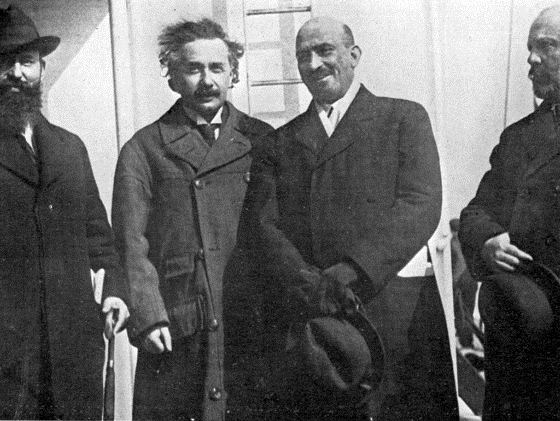 A century-old fermentation process to transform plant material into a propellant, could eventually replace gasoline.
A century-old fermentation process to transform plant material into a propellant, could eventually replace gasoline.
In 1914, thirty-five years before Chaim Weizmann (pictured center beside Einstein) would become Israel’s first president, he discovered a fermentation process for harnessing bacteria to produce large quantities of useful chemicals. For this discovery, Weizmann was called the father of industrial fermentation. The bacterium Clostridium acetobutylicum was named the Weizmann organism, giving him a taste of fame long before his Israeli political career. His process of Acetone Butanol Ethanol (ABE) fermentation helped produce explosives for World War I and now a team of chemical engineers at UC Berkley are close to perfecting his process for the efficient production of biofuels.
Weizmann’s ABE process was initially used to produce acetone which was used in the World War I explosive cordite. Like Alfred Nobel and Albert Einstein, Chaim Weizmann might have wondered about the moral implications of inventing something which would be used as a tool of war.
But Weizmann once said,
“I trust and feel sure in my heart that science will bring to this land both peace and a renewal of its youth, creating here the springs of a new spiritual and material life. […] I speak of both science for its own sake and science as a means to an end.”
Dean Toste, Harvey Blanche and Douglas Clark are well on their way towards fulfilling Weizmann’s dream. Harvey Blanche explained that their variation on Weizmann’s fermentation process could efficiently convert corn, eucalyptus, sugar cane, grass and other fast-growing plants and trees into the ACE mixture. Then a catalyst developed by Dean Toste converts this mixture into a high-energy biofuel. Their results are published in Nature.
“You can take a wide variety of sugar sources – from corn, sugar cane, molasses to woody biomass or plant biomass – and turn it into a diesel product using this fermentation process,” said Harvey Blanch in an SFGate article, adding that about 90 percent of the raw material remains in the finished product, reducing the loss of carbon. “Grasses are also a possible source. Eucalyptus could also be used. Anything that’s fast-growing.”
California is expected to be the first niche market to use this new biofuel, although it would likely take about ten years to go to market.
Photo of Chaim Weizmann with Albert Einstein via Wikimedia.



Hemp cannabis would be a good source of raw material if the key characteristic is “fast-growing”.